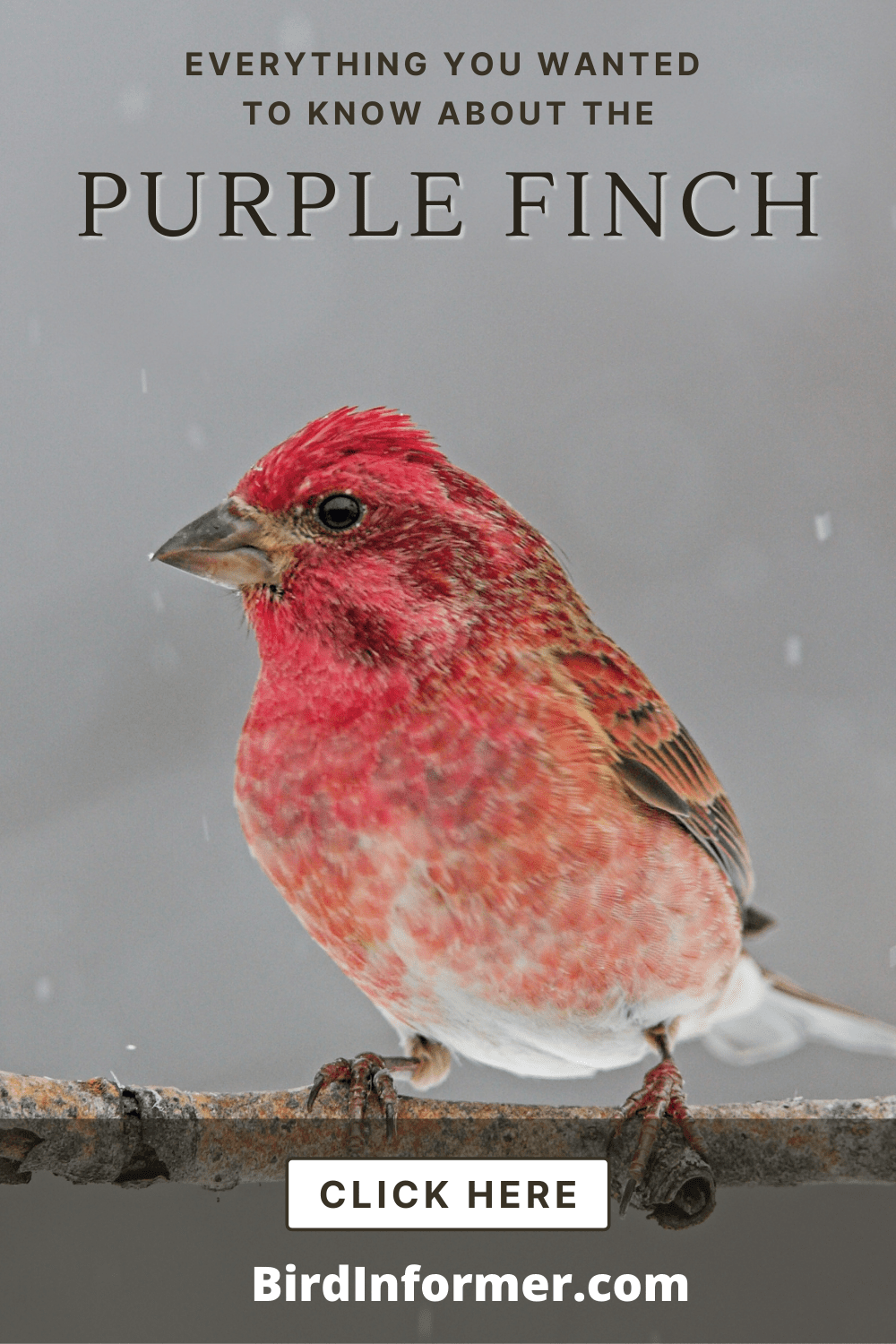Contents
The Purple Finch is known as the “sparrow dipped in raspberry juice” because of its reddish color. They have a very similar resemblance to House Finches but appear to be redder. They are irregular backyard visitors in winter as their movements would usually depend on the food sources.
In this article, we are going to cover a wide variety of topics related to the Purple Finch, such as:
- How to identify them
- How, when, and where they migrate
- Their diet
- How and where they nest
- And much more…
So, without any more delay…
Let’s jump right into it and learn more about the Purple Finch.
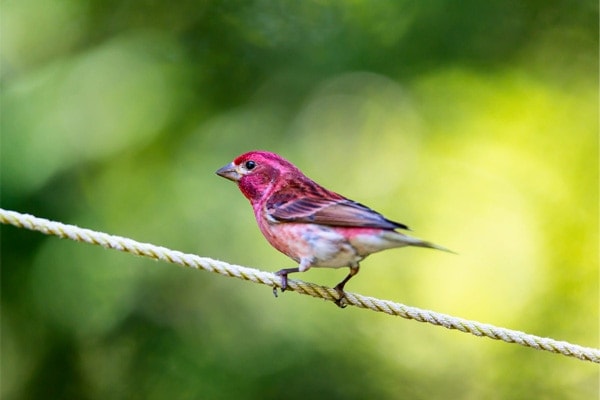
Purple finch facts
- Common Name: Purple Finch
- Scientific Name: Haemorhous purpureus
- Scientific Family: Fringillidae
- Life Span: 3-4 years
- Size: 4.7 to 6.3 inches
- Wingspan: 8.7 to 10.2 inches
- Weight: 0.6 to 1.1 oz
- Conservation status: Least Concern (LC)
Purple finch: how-to identify
Purple Finches are small-sized birds that have chunky bodies. They also feature large, conical bills and short, forked tails. Although called “Purple” Finch, these birds are not purple. Instead, they appear rosy-red, especially on their head. Unlike other finches, these birds lack the streak details on their bodies.
Differences Between Male & Female
Male and female purple finches show a significant difference in terms of color patterns.
Male Purple Finches are the ones who have the rosy-red to raspberry red color batter on their head and breast area. You’ll then notice some hint of brown color on their back, and their bellies are white.
Female Purple Finches, on the other head, have no trace of the red color. Instead, they have dark brown streaks, a white eye stripe, and a dark line in their throat. The overall look is just clean and plain, unlike the male birds.
Differences In Summer Plumage vs Winter Plumage
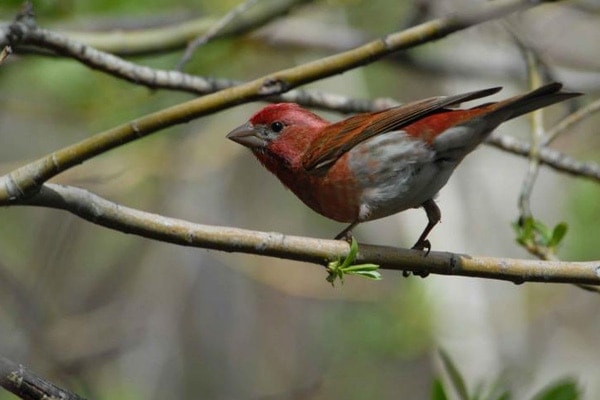
Purple Finches, particularly the male birds, change color throughout the year, depending on the season.
During winter, Male Purple Finches will lose all their red color and change to brown. Once spring arrives, you’ll notice a yellow to an orange appearance on their feathers. Then just in time for summer, they’ll go through another change from orange to bright rosy-red that everyone loves to see.
Purple finch bird vocalization
Where You’ll See Purple Finches
Purple Finches mainly inhabit the Nearctic region. Their range stays in North America, Canada, and some parts of Mexico.
These birds are often seen in open woodland, trees, gardens, and backyards. There are rare cases, though, wherein Purple Finches were seen in rocky mountain areas. They can also be seen in urban and rural areas but usually prefer rural residential areas and plantations.
Purple finch bird migration
Purple Finches are short-distance migratory birds, mainly seen in various regions throughout the year. They don’t have a consistent migration pattern, as movements usually depend on food sources.
They mostly leave their breeding grounds in Canada to winter across the central and southeastern US. Sometimes they appear down south every two years in northern Florida, Mississippi, Arkansas, and Texas.
Bird populations located in the northeastern United States and the Pacific Coast don’t appear to need to migrate.
Purple finch diet
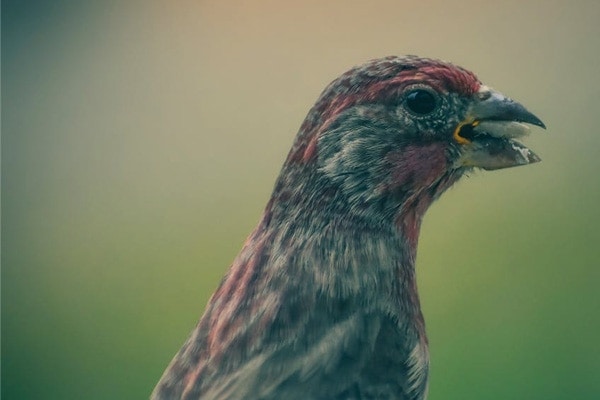
Purple Finches consume seeds the most, especially in water. However, their diet does change depending on food supply.
Since there are not many insects to find in winter, these birds would opt to feed on seeds. In spring, they would eat insects for breeding, and in summer, they would eat fruits when it’s most abundant. However, it’s found that they only prefer to eat the seeds of the fruits. There are also times when these birds will eat buds of trees and blossoms.
Unlike most birds who feed their young insects for protein, these birds would feed their young exclusively seeds.
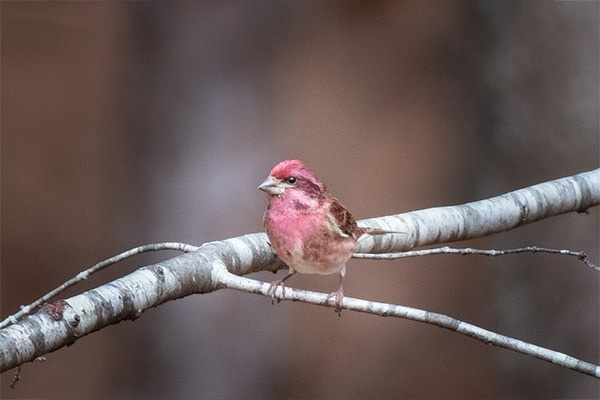
Purple finch nesting
- Clutch Size: 2-7 eggs
- # of Broods: 1-2 broods
- Incubation Period: 12-13 days
- Nestling Period: 13-16 days
- Egg Description: Pale greenish blue marked with brown and black
Purple Finches are monogamous birds and would only breed once between April and August. Once a pair forms, both the male and female birds will choose the location, which is often found 2.5 to 60 feet off the ground on the limbs of deciduous or coniferous trees. Sometimes, these birds will also nest in shrubs.
Female birds will do most of the nest construction while the male collects the materials. The outside of the nest is quite rough, with fine rootlets and lined with hair inside.
Purple finch behavior
Purple Finches are social birds during winter. They are often found in flocks and sometimes with different species.
However, during the breeding season, these birds become territorial and aggressive. Most of the time, both the male and female birds sing a song to defend their territories while sitting on the nest. They then give a “tick” call when in flight to keep in contact with others.
Sometimes, these birds will even use body language to communicate, especially during an aggressive situation. They have three aggressive positions; low head forward, high head forward, and display their bill.
How-to attract purple finches
Purple Finches don’t have consistent migratory patterns and may show up in your backyard this year and not show up the following year. However, if these birds visit your area, it’s very simple to attract them.
All you need is to provide them with their needs.
Start by placing some feeders all over your yard. You can choose a hopper, platform, or tube feeder. Then, fill it up with millet, nyjer, or sunflower seeds. After that, you can plant some fruit and seed-bearing trees, shrubs, flowers, and vines all over your backyard for extra food.
If you want to go the extra mile and provide a nesting area for these birds, you can plant some evergreen trees. And lastly, don’t forget to place a birdbath for some water supply.
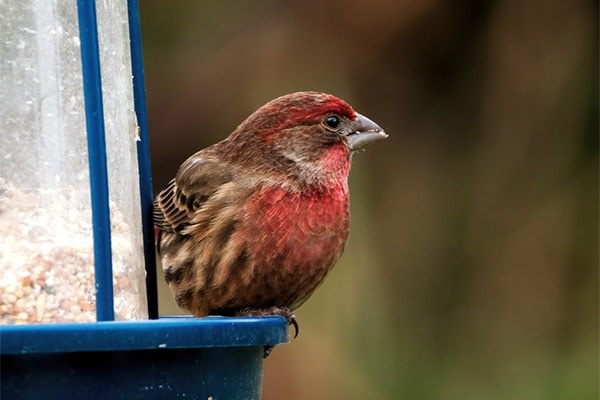
Purple finch threats
Purple Finches belong to the “least concern” group of birds regarding conservation. However, it is found that their numbers are experiencing some decline, mainly because of competition with House Finches.
Predators are also major threats and would usually target their eggs and young. Among their predators are blue jays, grackles, squirrels, owls, hawks, and domestic cats and dogs.
Purple finch fun & interesting facts
- The Purple Finch is the State Bird of New Hampshire.
- Although referred to as “purple”, these birds are rosy-red in color.
- They were the first ones to be introduced in the Eastern United States before the house finches.
- They would sometimes add in sounds of other birds in their songs.
- They are known as the Roseline Pourpre’ in French and Gorrion Purpureo in Spanish.
- The oldest recorded Purple Finch lived for 14 years.
- Evening Grosbeak
- Pine Grosbeak
- Gray-crowned Rosy-Finch
- Black Rosy-Finch
- Brown-capped Rosy-Finch
- House Finch
- Cassin’s Finch
- Common Redpoll
- Hoary Redpoll
- Red Crossbill
- Cassia Crossbill
- White-winged Crossbill
- Pine Siskin
- Lesser Goldfinch
- Lawrence’s Goldfinch
- American Goldfinch

